The Ministry of Defence (MOD) has announced plans to award a contract to Kongsberg Defence and Aerospace AS for a study on the Kongsberg C2 Vanguard Design, according to a tender notice.
This contract aims to investigate whether the pre-existing commercial ship design can serve as a viable foundation for the UK’s Mine Hunting Capability (MHC) Offshore Support Vessels (OSVs).
The MOD’s initiative comes as part of a broader strategy to acquire up to three vessels designed from the outset to be motherships for autonomous mine-hunting boats.
According to the tender notice, the MOD intends to place a contract with Kongsberg Defence and Aerospace AS for a short study of their commercial ship design, which was initially proposed to the Norwegian Navy.
The study will help develop and de-risk a potential UK requirement for MHC OSVs. The contract, valued between £150,000 and £300,000, will run from 1 August 2024 to 31 March 2025, with an option to extend for up to 12 months.
In the tender notice, it was stated, “The Authority intends to place a contract with Kongsberg Defence and Aerospace AS for a short study of a pre-existing commercial ship design proposed to the Norwegian Navy, to enable the MHC Delivery Team (DT) to develop and de-risk a potential UK requirement for MHC Offshore Support Vessels (OSVs).”
The MOD’s decision to contract with Kongsberg is based on the unique technical knowledge, experience, and rights that Kongsberg Defence and Aerospace AS holds over the commercial ship design.
The notice highlighted, “The Authority’s decision is made for technical reasons, since only Kongsberg Defence and Aerospace AS have the necessary technical knowledge, experience and rights in the pre-existing commercial ship design to provide the required support and analysis.”
The MOD also aims to ensure that these new ships are built to higher damage control and survivability standards than those of a merchant ship conversion, like RFA Stirling Castle, the mothership for minehunters expected to be deployed around the relatively safe waters of the UK.
The notice also emphasised, “The participation of Kongsberg Defence and Aerospace AS in no way precludes involvement in any downstream competitive process for a potential MHC OSV requirement. The intention is to prove that a commercial ship design is a viable way forward and enable that the Authority’s subsequent definition of a requirement for a potential MHC OSV capability will ensure an open and fair competition.”
According to the builders, Kongsberg Defence and Aerospace AS, the VANGUARD system is designed to “ensure mission success in territorial waters surveillance and protection”.
The system is adaptable and affordable, built around a multipurpose hangar supporting helicopters, UAVs, and USVs. The ship is designed for organic vehicle launch and recovery in high sea states, with the hangar optimised for new tasks and equipment maintenance.


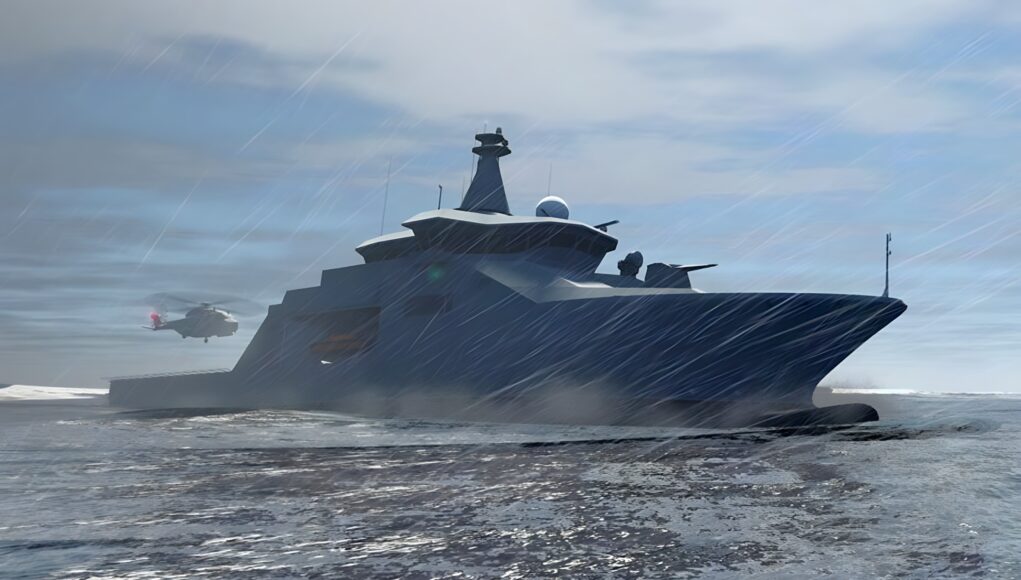
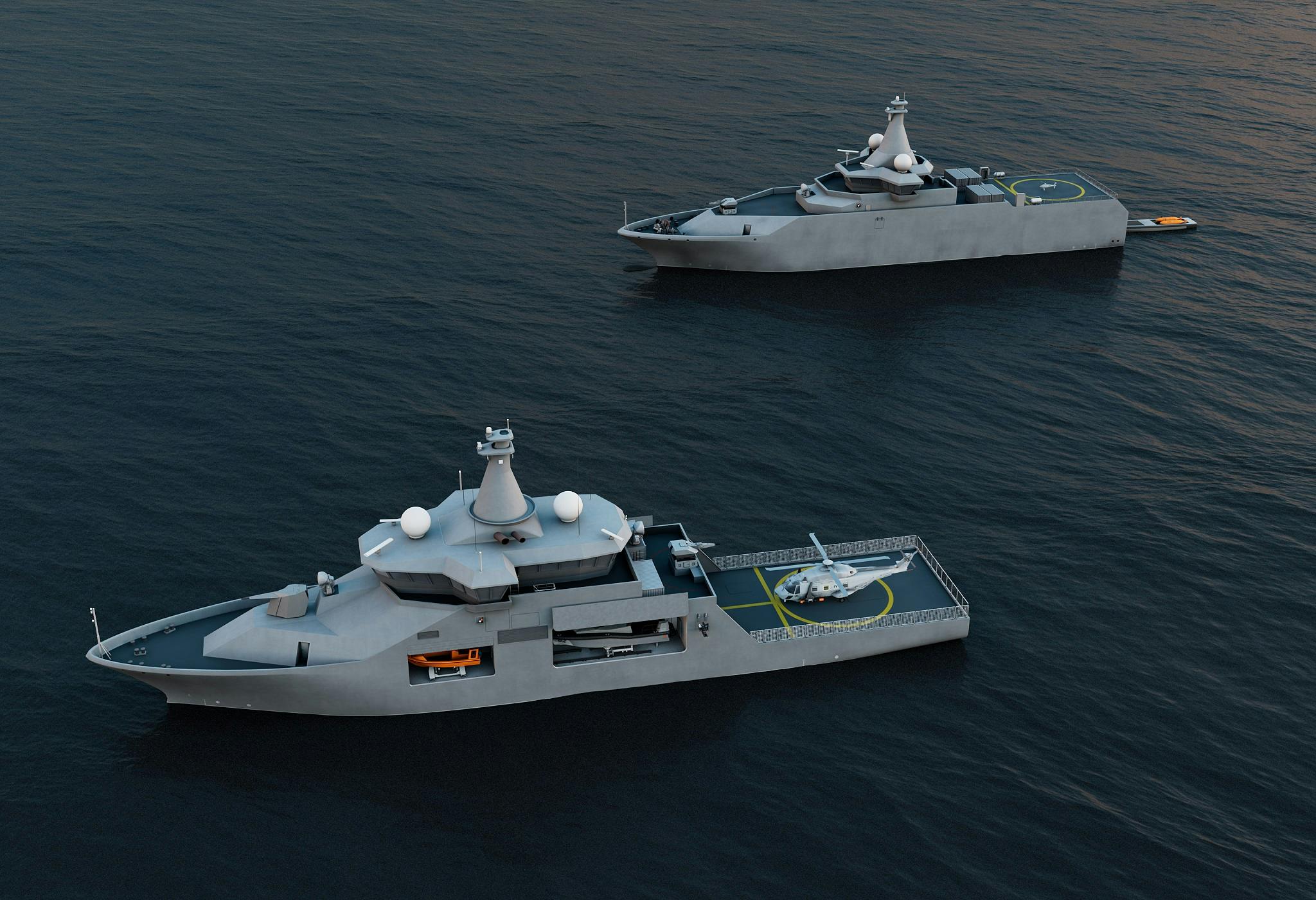
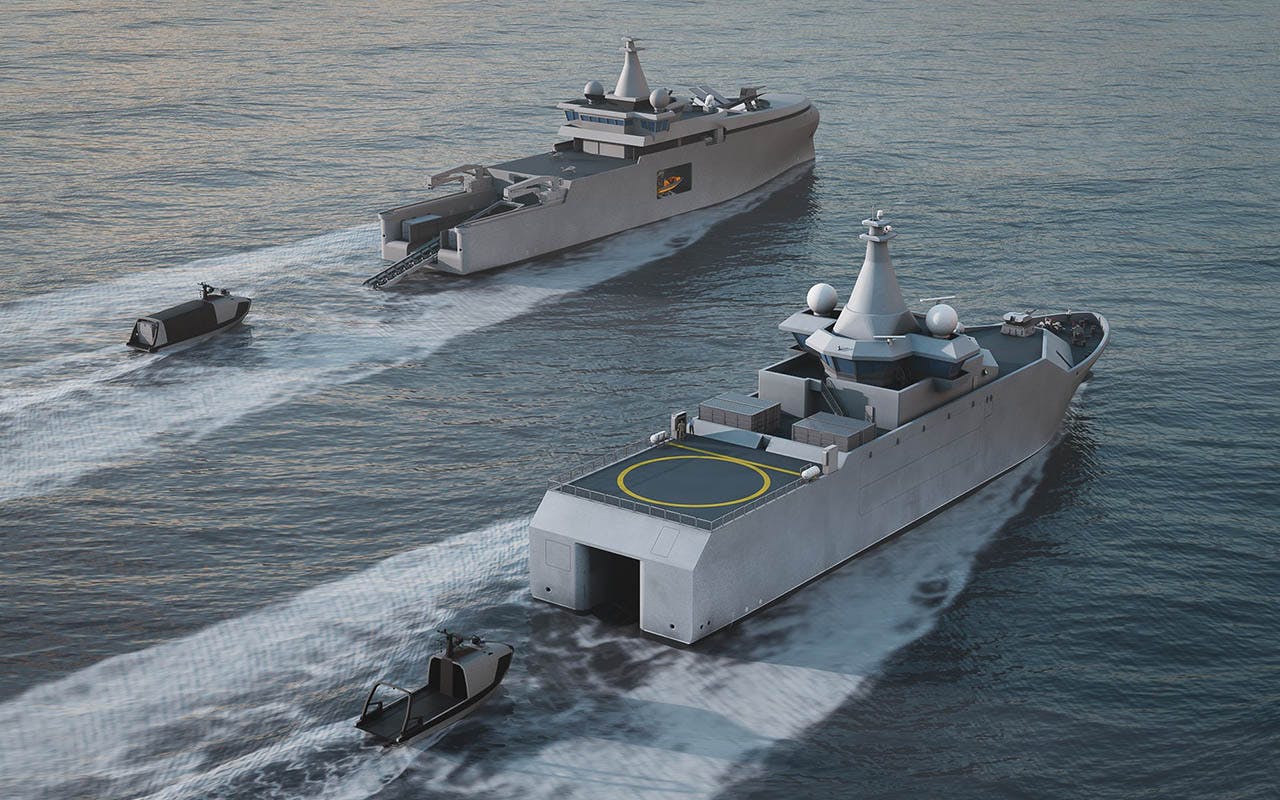
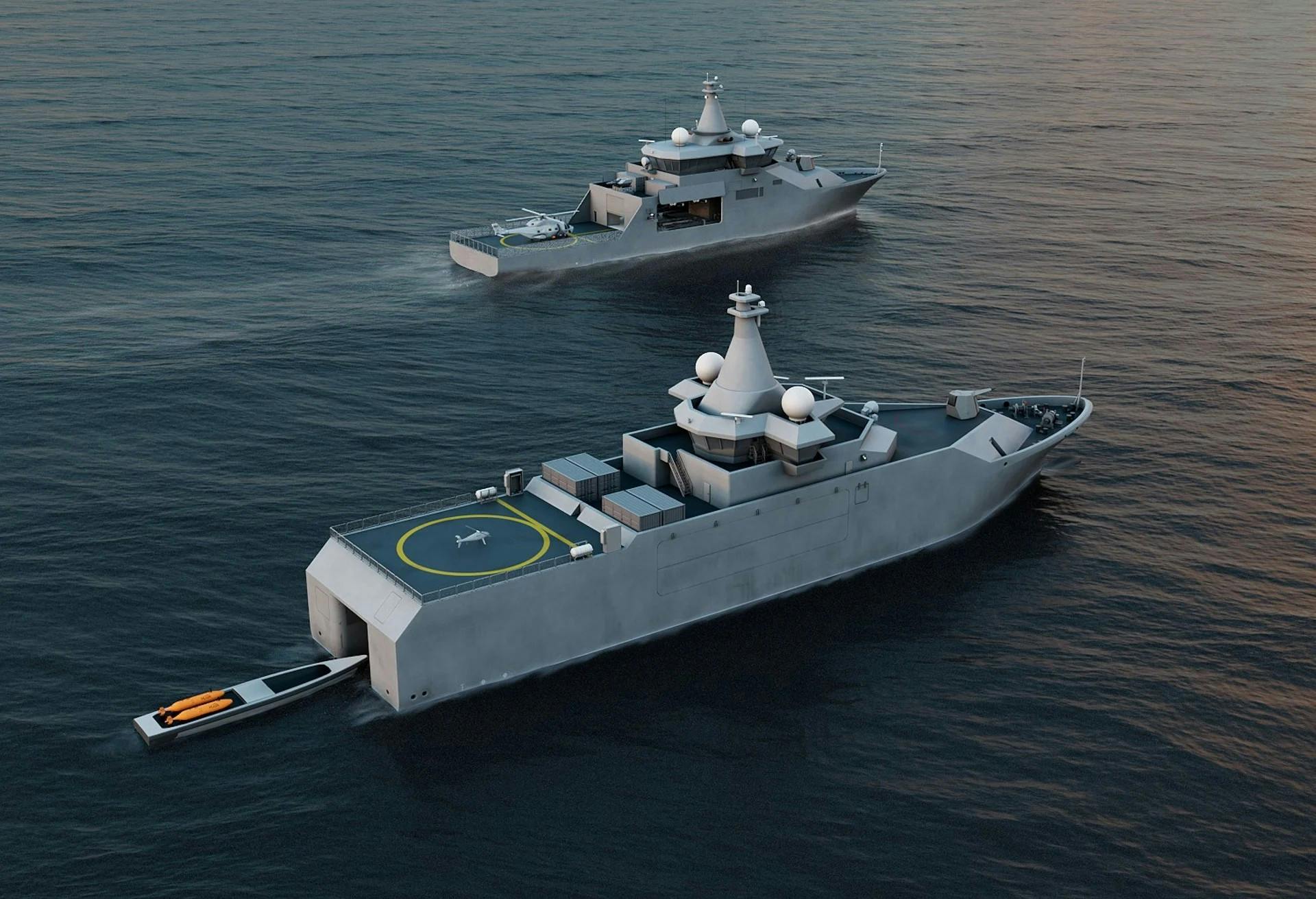
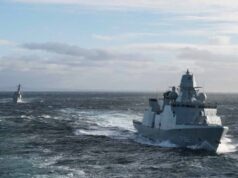
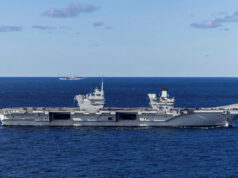
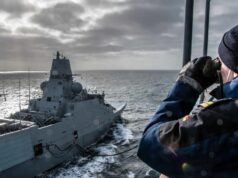
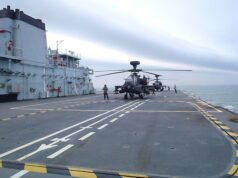

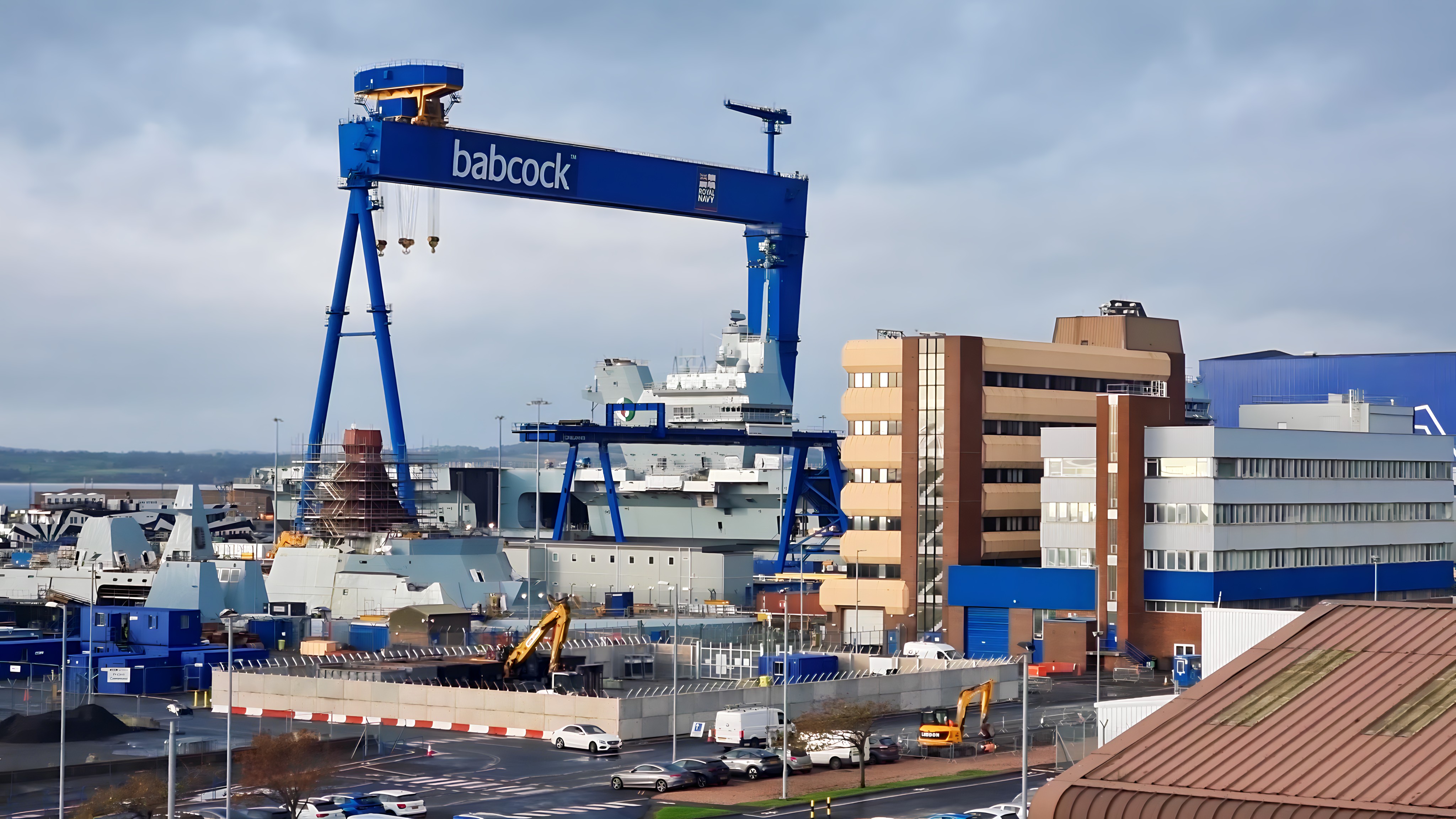
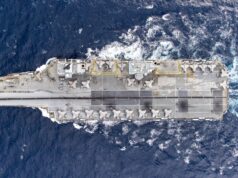

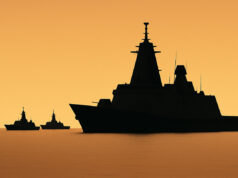
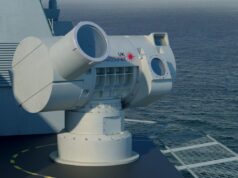

Not much Information on the net, looks like a whole series of design concepts with minimal detail on size and tonnage, the Kongsberg promotional video is quite interesting to watch.
Link to the video?
sorry, I’m pretty crap at that sort of thing but if you go to Youtube and add it in the search section, you’ll soon find it.
The video also uses the UK and the example nation.
Kongsberg is Norwegian and these ships would likely be built in Norway
Is this being done with an eye on a reciprocal T26 order? I think we, and the Navy in particular, should work more closely with the Norwegians; in the event of a hot war we would largely be working closest to their coast.
Yes and with Sweden too, I also think the Italians are coming up with some great designs, DDX for example.
Dont see us cooperating with Italy anytime soon, seeing as theyre sticking with systems like Slyver VLS and were moving onto Mk41. Plus with the History of the Horizon program it probably wouldnt work out.
Working with Italy is and has been a thing for many years though and Leonardo are a huge contributor to many projects Tornado,Typhoon, Merlin, GCAP/Tempest, Wildcat, various systems to name a few. The T26 Exports are good examples of individual system requirements differing from the original design, I don’t see why we can’t work with them on ships too ?
Sorry should’ve specified working with Italy on ships.
And reason it’s unlikely is because of our differences in tech we use, operating requirements and where we operate as well.
Also don’t forget the Horizon program debacle
T26 worked for other countries after being modified, but it was very nuch built for us.
I find it unlikely we’d buy into a foreign design and adapt it for our needs when it comes to such a key program such as our Future air defender.
I mean you don’t have to stop co-operating just because one country wants to use Sylver and the other wants to use Mk41. At the end of the day you still have to design a large void into the ship to accommodate a heavy VLS system. Theoretically there’s nothing to say you can’t design the void with dimensions that will accommodate both both Sylver and Mk41 (if you can make a Inspiration have a space that can either accomodate a CAMM farm or a Mk41, no reason you can’t have a space that accomodates either Sylver or Mk41).
Vls is only one of the many differences between our tech and theirs. But a big factor to consider is that we won’t be building ours for another 10 years at least. Will be alot of new tech between now and then.
I suggest you look at the differences between Italian and French FREMM’s, Different Engines, different radars… and still they made a very successful Frigate.
I’d argue the issue isn’t Italy…it’s us.
How is it an us issue for having different requirements, your Fremm example is odd seeing as it highlights that even a program that aimed to be highly cooperative ended up with 2 nearly completely different ships. We shouldnt bend our requirements to buy into an existing design and were not going to due to the timelines anyway.
^This attitude? This is why the UK drops out of things like Horizon, while other countries make succesful products. The point of FREMM is to show both Italy and France are more than capable of doing a joint project, that despite differing requirements creates a great Frigate that has even seen export success.
Sometimes if not most times joint programs just don’t work out, and if we want to talk successfull, look at the T26, built for us and modified for others.
At least with the Netherlands MRSS cooperation we pulled out well before any concrete items were being discussed.
T-26 wasn’t a joint program, it’s program that we made and then sold, and the buyer made some changes. That’s a very different thing. So no, not a successful joint program, that takes into account the needs of all three users.
If T26 was a joint program Canada and Australia wouldn’t have had such a long lead time redesigning them for their needs.
I literally said “built for us modified for others”
I know what you said, I’m pointing out that in the discussion about the UK being able to work well with others in joint programs, T26 is irrelevant.
I wouldn’t say its irrelevant, I think it shows a better way of doing it than trying to do a joint program.
It’s not a better way of doing it, it’s a different way. In this case one that requires the UK to take on all the cost of developing and all of the risk, which is what a joint program is specifically meant to avoid.
If T26 had been a joint program we’d be seeing the first Canadian and Australian hulls in the water right about now, so “better” really is subjective here, and why I’m pointing out that it’s kind of irrelevant to the central point I was making: The UK is the issue with joint programs, no the Italians (That was the conversation we where initially having remember?)
T26 was never going to be a joint programme so you wouldn’t be seeing Canadian and Australian versions in the water right now.
There are 2 main reasons for that, firstly neither had a Frigate requirement when the T26 was being developed, their timescales didn’t fit in with ours.
Secondly Canadas SB capacity is full with other projects right now and everything they touch seems to take ages and cost a fortune. If you take a look at the MV Asterix and the new Protecteur JSS the costs are mind blowing.
Australia was slightly better off but again most of their yards were busy till very recently.
The great thing about the T26 was it was designed from scratch to have space for growth and the flexibility to accept other non U.K. weapon systems and sensors such as AEGIS.
It was a hypothetical? Pointing out that there are advantages and disadvantages to joint programs vs single nation lead programs with exports, and that one isn’t inherently better than the other.
So what if the UK doesnt fit with joint programs, we split from the horizon program and got more ships and a great radar system. Not going to deny the other flaws in the T45 design but i think the point is we shouldnt bend over backwards just to fit into a joint program if it doesnt suit us.
Let me remind you this is what sparked this converation:
-Hugo
The argument was that you didn’t think the Italians could stick with a joint program and we should avoid working with them, and I pointed out that if anything, they should avoid working with us.
And no, it wouldn’t mean bending over backwards, in fact, if we’d have stuck with Horizon and saved development costs we might have ended up with the full 12 ships, or at least 8, if we hadn’t had to swallow the entire development cost ourselves.
I think that potentially answers your “So what”?
That statement wasn’t slandering Italy it was just highlighting one of our differences. I don’t think we should avoid working with Italy on naval programs, but I do believe it’s unlikely for any of our upcoming programs.
Which Key T45 tech would you have dropped just to stay in the Horizon program.
I’m loving this…
If it meant getting 8 or 12, I’d happily have let the project be HQ’ed in France, which was the real show stopper.
The issue with Horizon was the French.
There were 2 main reasons we pulled out.
Firstly we wanted a far more capable AAW system than France or Italy, hence we went for an AESA radar (SAMPSON) and they went for PESA(EMPAR). Funnily enough they are going to be upgraded and fitted with a Kronos AESA radar.
Secondly there was the 3rd Partner, France insisted on the Project headquarters being in France and the workload being an equal 3 way split. So we buy 6, they buy 2 each and want 1/3rd of the overall build.
The latter reason was real killer and we walked.
FREMM on the other hand has been a real success but more so for Italy than France as they built a far more capable version.
To be fair Dern, Horizon and T45 differ in that the RN is a true blue water Navy.
France and Italy (at the time) were very much focused on the Mediterranean.
T45, despite the Government mandated engine balls up issues, is the more capable ship in heavy seas, Atlantic etc…
I like are new ship building strategy, we design then, other folks buy and adapt it…
Working with the French and Italians ends up designing by committee…..
The French Navy has a bigger presence in the Pacific than we do, they’ve had a continous carrier capability, while for half the service of the T-45’s the RN was on a Carrier holiday, the French have 3 LHD’s the RN has none.
I don’t think that saying we’re a “true blue water navy” and that the French aren’t comes close to holding water.
The FREMMs are a great example of how Italy will work with another nation to develop a common hull that’s in effect a completely different ship…the FREMMs are all unique beasts…
Never said any ill of the Fremms, successful program but still demonstrates the limits of international cooperation on a ship design.
I think that’s the point and why British navel shipbuilding has seen a renaissance with the T26 and T31..every nation needs and wants its ships to be outfitted with completely different sensors, effectors, counter measures and sometimes even propulsion…but single nation building of unique ships is not affordable or efficient..unless your the US or china…so a standardised hull that can be customised easily is the only way.. if we can work with Italy or anyone else to design a large destroyer hull that can be custom fitted for propulsion, sensors and effectors..why not…trying to build a single ship with shared sensors and effectors ( like the horizon ) will fail…but just a shared hull form…
Well that’s what I sort of suggested, after all we do integrate systems from so many different companies to all platforms. Not sure what the problem actually is with working with the Italians really 🤔.
indeed, I think the Italians are pretty good partners…it’s worked with rotor. The French are harder as they are profoundly protective of their defence industry..
Yes, the DDX design looks great, shame that the Americas bought it and cut it up with a scalpel.
I doubt they would be built in Norway.
Much more likely to be built in one if the two huge frigate sheds in the UK.
We can probably build them cheaper than they can – Norwegian labour costs are extortionate.
I don’t think that’s the case
Rosyth won’t be free until well after 2031 and Glasgow is either going to pack as much of a Norwegian order in as they can in before inevitably building T83, or maintain the current deliberately slow build.
Unless Appledore can build 3 (90m?) ships in that timeframe, they will need to be built in Norway.
The main issue is people rather than workshop space TBH.
T83 will probably build alongside the back end of the T26 run.
I’d be interested to see how the build method changes to perhaps mega blocks. There is the original BAE build shed to consider.
Or god help RN ……Fergusons……can’t believe I just said that……
T31 is running very, very late anyway.
We might just be able to run a distributed build using Ferguson and Appledore at a push.
Fergusons build blocks and ferry them down the west coast to Appledore for assembly.
I’m still not sure about the timeline for T83. Publicly so little work has been done on it that it is imagine what the build will look like. 2035 is a long way away, but the design needs to be done by 2028 at the latest.
1 – Usage case
2 – Sensors required to meet usage case
3 – Effectors
4 – Budget meets concept – iterate
My betting is on a bigger version of T45.
A high radar mast will be required to allow a layered approach to area defence. So I see a son of SAMPSON in that role.
The volume search capability will likely be flat panel but these will be low mounted as they will be fused into one radar system of systems with low level to Horizon with son of SAMPSON and look up volume on the panels.
This way you can have massive panels and really high power as it isn’t a top weight problem.
That’s what I think will be the radar setup.
X- or S-band son of SAMPSON rotating large or fixed small panels at the top of a tall mast.
L-band volume search panels doing S1850s job fixed on the superstructure.
The thinking is now moving towards the large destroyer/cruiser as the solution for the ship.
It will be interesting to hear about the other components of FADS and how much will be offloaded from the platforms themselves.
Hopefully we hear more about that from the upcoming defence review.
This is where CAMM & CAMM-MR comes in….
Can the density of packing allow the number of silos on a T45+ platform?
Do you need the complexity of Mk41 or SYLVER for that? Not really.
I don’t think we will get a genuine T45+
We have moved on so far in ship design since those were done and the doctrine is different.
I really hope we get CAMM-MR in its own silos in a split arrangement or twin-packed in ExLS.
Then mk41 holds the first class missiles; BMD, long range AAW, FC/ASW, perhaps the new ASW missile.
We will end up with something very like an anglicised version of the Italian DD(X) but with more than 72 VLS, maybe 64 mk41 plus 64 CAMM family. That along with the radar layout above would fit easily inside 10,000 tonnes.
57mm with guided rounds and Dragonfire for self defence and sorted.
Hmmme
The doctrine has moved on a bit but the fundamentals of a very tall mast, stability and speed are still there. That kind of defines the hull form.
Hopefully fully IEP is still there this time with a better recuperator design!
It will be a mixed Hi-Lo missile load out for sure.
You need Mk41 for high end missiles for BMD or strike weapons. Camm is an ok weapon but its no aster let alone capable of dealing with hypersonics or ballistics
I think you underestimate CAMM.
Sure CAMM isn’t doing BMD it was never designed for that role.
ASTER is better for some things.
All are part of a valid weapons mix.
Certainly CAMM has the potential to increase missile capacity at a lower cost, still interested to find out what will cover BMD etc. SM6 perhaps. Still unsure whether we would be able to get Aster or it’s successor into Mk41
MBDA got burnt, through Sylver. It missed out on a load of Aster sales, because although Aster can technically be used from Mk41, only simulated trials were done. Not a full integration and firing.
Sylver is owned by the French Government, as it was designed by DGA. Who are the French equivalent of DE&S. So there may of been some political push back on allowing Aster to be used with Mk41, to force Sylver as part of the weapons a package with Aster.
That’s never going to hold up in the long run. Either the UK will stop buying Asters or France will have to remove whatever political brakes they have put on MBDA. Asters are great missiles, but now we’ve broken ranks on the silos, Italy is going to get mighty pissed off at France if Asters aren’t even allowed to be integrated into Mk 41.
Putting Asters in Mk41s will be a litmus test for the Royal Navy as to whether the next generation of ships even have Aster, which is currently the Navy’s preference. We know FC/ASW will be integrated into both VLS systems. France isn’t going to the matresses over this.
I have a feeling the T83 will prohibitively use the Mk41 VLS, As it doesn’t make economic or logistical sense to use two systems of VLS that are essentially the same (The Sylver V70 is 70cm shorter in length than the Strike Length Mk41, which may be important!). The issue is that Sylver has not been integrated with non MBDA products. Therefore it is severely constrained on wants to buy the system.
Aster’s Block 0/1NT US equivalent is the SM2 Block3C. Performance wise I would say Aster is ahead due it’s better radar and the mid-body piff-paff reaction jets, that can be used during the terminal phase. Therefore it is more likely to be used on the forthcoming T83.
However, it does not have the reach or flexible target set that SM6 has. This could be partly remedied by fitting GPS to Aster, along with a software upgrade. To allow it to attack land and ship targets. Reach is a problem, as the second stage dart is quite small. It is a similar size to Meteor. Which means that to get more fuel in to it, it will have to grow and get fatter.
The SM6 would give the RN a better chance of intercepting MIRVs as they re-enter the atmosphere. But the ship will require the longer strike length Mk41 to launch it.
MBDA have been contracted to design a SM6 equivalent with the Aquila program. Specifically to counter hypersonic glide vehicles and hypersonic cruise missiles. However MBDA are starting from scratch, whereas Raytheon has had 20 years to get SM6 to where it is today. After the conception phase then the design/development phase. The first prototype missile probably won’t be ready for at least 10 years (2034). Then there’s the trial and evolution phase which could be another 5 years. So realistically we would be looking at the early 2040’s before it could be properly fielded. Whereas SM6 is ready now.
Therefore for the T83’s multilayered air defence, I can foresee the Navy getting SM6 for the very long range and high altitude threats. As it’s available now and more importantly works. Backed up with Aster then CAMM. I could even see the Navy but I g a few SM3s, as MBDA have yet to say if they will pursue an exoatmospheric interceptor. However, MBDA will have to pull their finger out to get Aster properly integrated with Mk41, otherwise the Navy will look elsewhere.
If the ship is facing an attack from a hypersonic cruise missile, glide vehicle or even a ballistic missile, the ship will use everything at its disposal against the threat.
Therefore the question is can CAMM defend the ship from these types of threats. The original requirements for CAMM did not include these threats in its scope. But I bet it does now. As ballistic missiles fired by the Houthis although inaccurate are still a threat. A similar question was asked about whether Sea Viper Block 0 could defend a ship against ballistic missiles. HMS Diamond has laid that question to rest.
The primary issue is that we do not have a drone target that can travel at those speeds to physically test. So we have to use computer based simulated modeling instead.
The ship’s radar, be that Artisan, Sampson or the new NS-100 will be able to detect and track these threats. The ship’s CMS will be given a software update to work out interception points based on CAMM’s specifications and the threat’s speed. CAMM will need a software update to its proximity fuze. CAMM is classed as a hittle, the proximity fuze is a back up. If it slightly misses, the timing of the fuze is critical. As the fragmentary cloud must be in place for the hypersonic vehicle to pass through. Otherwise there won’t be enough fragments to cause enough damage.
The issue for a standard CAMM would be its ability to intercept a crossing target. The window of intercepting a hypersonic target will be very narrow in this circumstance. CAMM-ER and MR especially will have more time to intercept a crossing target, due to the larger rocket motors.
Has HMS Diamond ebmngaged a ballistic missile? Haven’t heard that…
Yes, check out the following link:
https://www.royalnavy.mod.uk/news-and-latest-activity/news/2024/april/25/240425-hms-diamond-shoots-down-a-houthi-missile
Also check out the links of the ship returning home. Where they show the row of ship’s kills. One of which is a ballistic missile.
Yes, answer is going through authorization, as I added a link.
My money is on a decade of bouncing around…trying a small hull with dispersed effectors..before starting to design a 10,000 hull..by which point the T26 work will be drying up and there would be no likely T83 until the early 50s…the government in power have a “shite the yards will close and we will start to run out of dedicate AAW ships in the late 40s” moment at which point they order an emergency T26 follow-up batch focused on AAW…to keep the yard in work and ensure we have some working AAW ships in the 2050s to tide over until the 4 ordered T83s are launched…that’s my bet…😂🤣 and on previous form you know it’s happing.
The must be some T83 work having been done in the background as didn’t BAE propose sone AAW destroyers to the RAN before the enhanced T26 Hunters? They wouldn’t have put forward a non working proposal. The Italian DDX looks like it could be very useful base design. It’s going to be interesting with the FC/ASW which being Anglo-French must be designed (for both versions?) to be launched both from Sylver and MK41 and why can’t they then make the Aster family and future developments do the same?
BAE I think put forwards the GMF variant with extra VLS because there were groups in the Australian navy complaining that the new ships couldn’t compete with Chinese surface combatants (no VLS AShMs ordered for the Hunters). CEAFAR is a very powerful system so there’s no reason it wouldn’t work as a destroyer.
The problem is that using the T26 hull in that way goes against what the Navy have been saying ever since T45.
BAE have already had to enlarge the hull to fit the massive radar, so there would be no room for new VLS or radar upgrades.
DDX is the opposite, with only 64 VLS on a 10,000 tonne hull. If it could be anglicised with our radar, weapons and mk41 it would be a useful common platform, but that sort of modification tends to end up costing more than a new design.
An example would be USS Constellation class. At what point do you still call it a FREMM, as the US have changed 3/4 of it from the baseline design.
Have you been to Appledore ? Its setup isn’t conducive to assembling blocks from elsewhere. IMHO it would make more sense to build blocks at both yards and assemble at CL in a Drydock. Or in an ideal world get Inchgreen back up and running.
HW have a hell of a lot of capacity for steel work across its medium sized yards.
These smallish sub hunter boats sound like a great idea . As you say I think uk should focus on building frigates and destroyers at a faster pace for domestic and export supply . There is plenty of work for uk ship builders to be getting on with
Not sure what you mean by sub hunters.
These motherships are specifically to do MCM in places that the platforms like Stirling Castle can’t go, like the Gulf or even the Baltic during a conflict.
One of the autonomous boats is supposed to be able to do littoral ASW, but the main role is mine clearing on a wider scale than a traditional minehunter.
“Rosyth won’t be free until well after 2031″
I’m not sure that’s entirely true, as Babcock can build two T31s side by side. I don’t think the programme of 5 vessels uses all of the new shed’s build capacity.
Theyre building 2 ships at a time so far as we can tell they are making use of all the space.
Morning SB, just a little question. Where did you get the “3” ships from? I thought the requirement here was for 4 or more? Even 4 doesn’t really sound enough.
There was a Navy Lookout article on June 24; “The Royal Navy wants three new-build minehunting motherships”
That suggests an OSV based design, rather than this which is more obviously a warship.
I do think we need more, but the official requirement is for three.
Evening from Aus SB, You’re absolutely right. I even read the NL article too! From my couch here I reckon six would be better. But I know nothing. Lol 😁 😎 🇦🇺
SB other than the Skjold class FACs, not even the Norwegian Navy has ships built in Norway. HNoMS Maude – S Korea, Nansen Frigates – Spain, Submarines – Germany.
And yes we can certainly build them, but if they are RFA then ….. 🤷🏼♂️
I tend to agree, the defence of Norway is crucial and we are best placed to do so (along with new members Sweden and Finland) for if Norways were taken or became a Russian puppet it would transform the balance of power in the artic and northern North Sea and of course leave part of the British isles closer to the enemy than to mainland Britain. Sweden and Finland joining is indeed a massive road block to any such Russian plan thankfully as one can only imagine the drawn out hiatus of a united response to any such attack on those Countries and thus the vulnerability of Norway previously despite their vital importance to Western defence.
It’s a pretty decent looking design and being based on a commercial baseline should be cheaper than a new purely naval design.
Had a good look at the design History and it probably explains more about why Kongsberg has been chosen. It’s slightly complicated but actually very logical so here goes.
RFA Stirling Castle is a VARD UT-706 OSV, VARD is a Norwegian commercial shipbuilding and design company, but most of their ships are built in Romania (cheap labour costs).
But the design isn’t Norwegian, VARD had a licence to produce and market variations the UT series of designs from RR Commercial Marine. Yep the RN bought a British designed ship.
Kongsberg is also Norwegian, but 5 years ago they bought UK based RR Commercial Marine for over £600 million. Including all the design rights to the existing RR designs including the UT series.
When you look at the hull shape of Vanguard and compare it with Stirling Castle the relationship is pretty obvious.
As to being built in Norway I doubt there is much chance of that happening, quite simply their Labour costs are way too high, which is why most Norwegian Naval ships are built abroad. But it would make a lot of sense for Kongsberg to act as design authority and the build could be here in UK or elsewhere which is cheaper.
It will be interesting to see which way our new Labour Government goes, I’d be really surprised if it’s not here in UK (Unions 😉 do have their uses).
They could tender them out so CL, Fergusons or Appledore could compete 🤔.
Fun Facts For Friday,
Norways largest Naval ship is HNoMS Maude which is a 27,500 tonne replenishment ship. She is a near sister ship to the RN Tide class (and future FSS), all of which are variations of the U.K. BMT AEGIR scalable modular design and built by DSML in S Korea.
HMNZS Aotearoa is New Zealand’s largest ship and she was designed by U.K. based RR Commercial Marine and built by Hyundai in S Korea.
Just because we don’t build too many ships here these days doesn’t mean we don’t design them.
Thanks for that, yes the UK design industry over all sectors is extremely important and influential around the World but gets few headlines, it’s one of our most vital industries with British designers much respected World Wide. People have often complained about T-26 designs not being built here but I read recently on Naval News how each ship built abroad of that design brings in around 200m so the potential for the design industry generally on all fronts, not to mention the skills it retains/creates is considerable.
I think we’re going to see the reverse in the defence sector, more European designed equipment built here. Why? Well, government favouring EU project participation but it wants UK manufacturing so a built in the UK element. Tick 2 boxes, closer to EU and more defence jobs(net)
Do you know if the design for Vanguard has come from a UK office?
It’s so hard to tell with all of these multinational companies where the actual work is being done.
It’s nice to hear all of the different places where UK ship design is still going strong. People do tend to focus on the actual steel cutting and ignore that we still have a lot of influence through our design bureaus like BMT, as well as through the shipyards themselves.
I didn’t know RR did ship designs, will look into that more.
Yes RR used to design ships and no great surprise the power plants that went into them. But they sold it off, and to be honest it made a lot of sense, RR was in a mess it was overstretched, underperforming and needed to focus on its core businesses.
Its no secret I spent most of my working life in a rather niche part of RR here in Derby and they just had to many pies and not enough fingers.
They concentrated on the core business in Aero, Marine, Land and Submarine Nuclear power system. They also invested heavily in the 2 Big Overseas acquisitions, RR North America (Alison) and RR MTU. My shares agree they got it right. 😉
No idea if Kongsberg still have design offices in U.K but the+one in Derby has gone, but I suspect they do (otherwise why buy it).
One thing I am sure about is just how successful the UT design was and I think Vanguard is heavily based on the RR UT 515 Patrol version. Check out Icelands Thor and you’ll see what I mean.
VARD is Fincantieri owned.
Yes and it has a licence to adapt and build the RR UT design, Kongsberg bought the RR business and hold the design authority.
RR did actually design an OPV version (UT-512L) for Iceland and it got built in Chile. Thor !
Nice looking ships, even if a bit boxy. The patrol variant here could be a replacement for the B1 Rivers?
Are these motherships then a separate requirement to or is this an actual T32 contender? I’ve been thinking that the T32 is more a GP Frigate, different from this MCM mothership.
Separating the function from T32 might well be a cost reducing effort?
Making a full fat warship sing and dance is very expensive indeed when a warship lite will do the job well.
The concepts here could replace all of our small ships with a single class, which I think has replaced T32 in Navy thinking for MCM.
We just need something with a helipad, 40mm and mission bay around 90m long to do everything.
Just need the UAV and a few large RIBs for OPV role, but swap that for the autonomous USVs and you can hunt mines just as well. I like it, never seen the inherent difference between what was needed for these and for the River replacement.
I’m not a huge fan of the aesthetics, but I suppose that high bow is needed for accomodation given the rest of the ship holds PODS and drones.
Wasn’t this what the 2012(?) Design study “black Swan sloop of War” was meant to be?
It was a bit poo-pood at the time I believe, but now….
Seems to me like it’s time has come.
AA
I’ve just skimmed through the original Black Swan paper, and I can’t find an obvious point of difference between that and what I wrote above.
It does have a strange emphasis on the ships working in groups, though, which is unlikely.
It’s now a given that unmanned is the way ahead, whereas in 2012 the tech wasn’t far enough ahead to stimulate the imagination of those in power.
I think the T31 would be more suited to the Norwegians budget/needs , also give a degree of commonality with their Danish neighbours too
Where do you get the idea Norway has a limited budget ? M8 they are one of the richest countries on Earth, they have 2 Sovereign wealth funds each of which could pay our National debt.
They have issued their requirement and they want 5 high end ASW Frigates with secondary AAW capability. As for commonality with a neighbour you’re absolutely right that’s in the spec and their biggest Naval neighbour is us !
Have a Google on Norways future Frigate programme. It’s a real beaut !
T26 is the ship being offered, they want High end ASW and from what i understand at least 1 ship off current production lines. the T31 were building isnt a suitable candidate to offer them.
Agree. The RN has already declared to the new …and better Labour government than they want between 7 and 9 drone mother ships for anti mine and subsurface warfare. These are in addition to any additional Proteus or RFA Stirling castle class ships.
So I’m happy if it’s a joint UK/ Norwegian design and build, especially if Norway then purchases 7 type 26 frigates.
We definitely do need to work closely with our real allies to leverage best possible price and capabilities for our NATO alliance.
7 or 9 sounds like the actual number needed as a replacement but I think the stated requirement from the Navy is for 3 to fill out the class with Stirling Castle (see Navy Lookout article)
That was as of June 24 but if as you imply the Navy wants more, a joint procurement with Norway and building in a third country makes a lot more sense.
“An innovative system for territorial waters Surveillance & Protection.”Sounds good. Replacements for the batch1 Rivers?
No, replacements for over 20 MCMV!
If they include the River B1s then that’s another cut if only 3 are procured.
I’m puzzled by this announcement. A large ship like Sterling Castle could support a lot of mcmv drones and sweep a large area but the smaller Kongsberg solution implies fewer drones per mothership. Perhaps the RN sees a role for both. Maybe the clue is in the title role…surveillance and protection.
The Vanguard concept is configurable so i imagine they could have one built to the size they need
I reckon there are similar discussions taking place in respect of size, number, crewing, capability of MRSS. It’s got to be easier to navigate through to an affordable shipbuilding plan if you start with different roles – mcmv mothership, amphibious and frigate rather than trying to design a Swiss army knife.
This is actually the final development of the C3 global corvette concept that was cancelled in 2010..and they were going for 10 in total..but that was for patrol and MCMV..so they were always going to cut the the bone on this…in the end it looks like we will get 5 rivers 2 and 3 mine warfare mother ships…an even greater cut….
when you think in 1990s we had:
12 river class mine sweepers
12 sandown minehunters
13 hunt class minewarfare vessels
5 peacock class patrol vessels
2 castle class patrol vessels
7 island class patrol vessels
that’s 49 vessels..now we will likely end with five rivers 2 and 3 mother ships…
Pretty appalling!
I’d long forgotten the River MCMVs.
The Peacocks looked good, I recall GB commented on those. Nice big gun.🙄😄
Yep 76mm the only RN vessels to ever have the OM 76mm compact ( a very good gun)…even island class was armed with a respectable bofors 40mm MK3…..I honestly don’t know why they ended up with the 30mm on the rivers…once the T31s come in and take over the east of suez deployments I honestly think they should stick a 57mm MK 3 on the Rivers as well as a 40mm mk 4 and use them as faster smaller well armed mine warfare, autonomous vessel motherships…really taking advantage of the 2000 tones ..
That at lest would give one large mine warfare mothership for home and deterrent protection…2 large mother shops for over seas..more benign..then five smaller upgunned rivers for when you want a smaller, swifter well armed mothership..
Morning DM, I know the Rivers well, made of steel doing deep trawl going after WW2 and Russian moored mines. Would role and pitch even on wet grass. The only vessel that I was ever sea sick on. All were Fleet Minesweepers (MSF) with MCM Sqn 10 of the RNR.
Morning Ron.
Yes, I recall you’ve mentioned your time on them before.
Were They all RNR crewed or with a regular contingent?
I usually only remember the 50 odd Ton sweepers from the cold war, then the Hunts, Sandowns. The Rivers passed me by.
I was on Helmsdale, she was all RNR crewed. I think they were all RNR manned except one. No idea why that was. It makes sense that many people forget about them as the complete class only served for about 10 years, Helmsdale only five before she was paid off. What a waste of investment.
Like the look of the top of the two in the image, looks to have an awful lot of space and flexibility available and indeed potential expandability looking at it.
Yeh, they do look the part. Are we in fact looking at Type32?
Actually, that was my thought as well, let’s not hope so unless more numbers are built otherwise it’s just another cut and don’t forget the Hunt and Sandown numbers they will be replacing.
I don’t think an ‘innovative system for territorial waters Surveillance & Protection’ translates to a frigate. I think there are 2 roles and 2 ships. That’s not to say a frigate should not have an organic mcmv capability in extremis if its the only vessel present. But for the frigate solitary roaming GP role or ASW escort we should just build more T31 or T26.
I think the T32 has no defined name yet, just a “Platform for autonomous vehicles” therefore it fits nicely in that category ? unless of coarse BJ just got confused !
Whoops, just said the same thing as you..
Lol 😁
We’ll put it down to the time delay 🙂
In terms of where these ships will be built then can I bring to notice that Luke Pollard , MP in Plymouth and I believe Minister of Defence with the new Labour Government said that mostly all new Defence contracts would be sourced to companies in this country to build and benefit this country and its workforce
I mean yes since the Tide class theres been more focus on building ships in the UK, but if he wants to back up that statement then they need to keep Harland and Wolff afloat.
Seems similar in concept to BMT Venari-85
This is the Vanguard System…
https://www.kongsberg.com/globalassets/kongsberg-defence–aerospace/2.1.-products/defence-and-security/naval-systems/surface-ships/vanguard_datasheet.pdf
Sorry, completely off topic… Come on 🏴, victory over 🇪🇸 in the Euro ⚽! Alcaraz can win the Mens 🎾! 😎 🇦🇺 🇬🇧
Just a thought but surely could the government not convert the two survey vessels HMS Enterprise and EHCO into this role save some money to give more platforms. Like I say just a thought guys 😏 🤔
If this project comes to fruition, they are going to need more than 3 ships ,it’s alright to bump their gums about technology but our coastal waters patrol areas come into 100s of thousands of square miles ,so the maths is there to prove it ,3 ships is not enough realistically 12 to 18 ships over a period of time,
This is going to be like Ocean where a ship is built as cheaply as possible to commercial standards and then falls apart. Or the type 23s with a 15 year design life and then asked to serve over double that. Build the ships properly to start with!
At least it would be more vessels. The Norwegians build decent ships. Our shipyards cant build the amount we need in the time required.
As usual send British tax payers money abroad rather than design and build anything here. The war is here and now and still our government is hell bent on destroying our industries to ensure we can’t defend ourselves. There are a huge number of shipyards around the UK needing work, including Harland in Belfast, this would be a lifeline for them
It seem’s to be on the small side for the requirement to me as you need around a thousand square meters to accommodate the RN’s Mine clearance USV’s.
This look’s much more interesting if you role in the type 32 requirement:-
https://www.navylookout.com/steller-systems-unveil-fearless-multi-role-support-ship-concept/